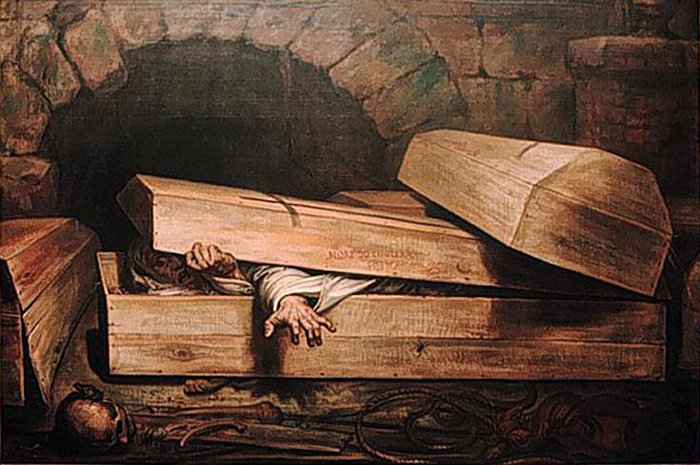Strange History Of Safety Coffins: From Ancient To Modern Times
A. Sutherland - AncientPages.com - The fear of being buried alive has been a constant companion of humankind for as long as anyone can remember. As bizarre as it might sound, certain variations of safety coffins designed during the 18th and 19th centuries are still in practice today.
The recovery of supposedly dead victims of cholera, as depicted in The Premature Burial by Antoine Wiertz, fuelled the demand for safety coffins. Image credit: Antoine Wiertz - source - Public Domain
Taphophobia is the medical term for fear of being buried alive due to being incorrectly pronounced dead.
Taphophobia can be justified due to the number of cases of people being buried alive by accident. In 1905, the English reformer William Tebb collected accounts of premature burial. He found 219 cases of near-live burial, 149 actual live burials, 10 cases of live dissection, and 2 cases of awakening while embalmed. Of course, Edgar Allan Poe's novel The Premature Burial, published in 1844, resulted in even greater fear, mainly since the book contained accounts of supposedly genuine cases of premature burial.
Therefore, it's not a surprise people feared coffins and graves.
During the 18th and 19th centuries, many safety coffins were patented. Many sarcophagi were fitted with a mechanism to allow the occupant to signal that they had been buried alive.
The first recorded safety coffin was constructed on the orders of Duke Ferdinand of Brunswick before he died in 1792. The Duke demanded to have a window installed to allow light in and an air tube to supply fresh air, and instead of having the lid nailed down, he had a lock fitted. In a unique pocket of his shroud, he had two keys, one for the coffin lid and a second for the tomb door.
The trouble with many designed safety coffins was that they included ladders, escape hatches, and even feeding tubes, but their creators forgot to implement a method for providing air.
In 1798, P.G. Pessler, a German priest, suggested that all coffins must have a tube inserted from which a cord would run to the church bells. If an individual had been buried alive, he could draw attention to himself by ringing the bells.
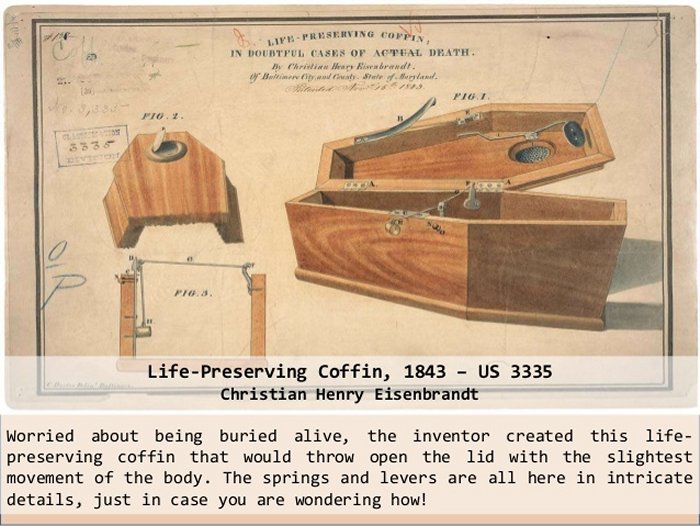
Pessler's colleague, Pastor Beck, suggested that coffins should have a small trumpet-like tube attached. Each day, the local priest could check the state of putrefaction of the corpse by sniffing the odors emanating from the box. If no smell was detected or the priest heard cries for help, the coffin could be dug up and the occupant rescued.
In 1822, Dr. Adolf Gutsmuth wanted to demonstrate his ingenious safety coffins. He was buried alive, stayed underground for several hours, and even ate a meal delivered to him through the coffin's feeding tube.
Improvement of safety coffins and their mechanism continued. In 1829, Dr. Johann Gottfried Taberger designed a system using a bell that would alert the cemetery night watchman.
In 1900, Walter McKnight of Buffalo, NY, patented an all-electric device for "indicating the awakening of persons buried alive." In addition to the usual air pipe to the surface, a giant electromagnet (solenoid) pulled up a cap on the air pipe when the movement of the corpse's hands closed a switch. An electric bell was mounted outside the enclosure.
A telegraphic grave signal device was patented in 1901 by Monroe Griffith of Sioux Falls, IA. In addition to the wiring of hands and feet to signal awakening and movement of the corpse switches under the corpse would close if grave robbers lifted the body. Rather than a buzzer above the grave, the wires lead to a central office such as "the home of the cemetery sexton or police station."
In 1908, George Willems of Roanoke, IL, patented a grave attachment that consisted of a pipe at the foot of the coffin leading to the surface, with an adjustable mirror at each end and a remote-controlled flashlight. The idea was to observe the corpse for several days after burial.
1913 brought a more sophisticated device for detecting a corpse "in hospitals, morgues, crematories, at bathing beaches and on ocean-going steamers." Peter Backus, of Delphos, OH, was the inventor. The elaborate apparatus consisted of a motor-driven vacuum pump, electric heaters, a telephone monitor, and a unique stretcher in a sealed casket. Presumably, a professional operated this apparatus and performed tests for residual life in the corpse.
As late as 1983, Fernand Gauchard of France patented a coffin life detector. The device used electrical relays and included a vacuum pump but still relied on the old standby of detecting body movement to trigger the alarm.
In 1995, a modern safety coffin was patented by Fabrizio Caselli. His design included an emergency alarm, an intercom system, a torch (flashlight), a breathing apparatus, a heart monitor, and a stimulator.
It is believed that the phrases "saved by the bell," "dead ringer," and "graveyard shift" come from the use of safety coffins in the Victorian era.
The fear of being buried alive is still with us today. However, it is interesting to note that no documented cases of anybody being saved by a safety coffin.
Written by - A. Sutherland - AncientPages.com Senior Staff Writer
Updated on October 29, 2023
Copyright © AncientPages.com All rights reserved. This material may not be published, broadcast, rewritten or redistributed in whole or part without the express written permission of AncientPages.com
Expand for referencesMore From Ancient Pages
-
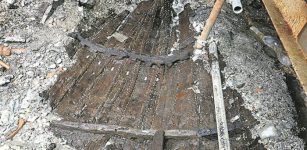 Ancient Roman Wooden Sewn Boat Unearthed In Croatia
Archaeology | May 3, 2020
Ancient Roman Wooden Sewn Boat Unearthed In Croatia
Archaeology | May 3, 2020 -
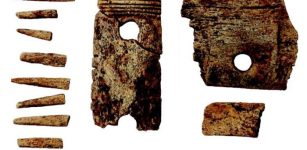 Large Anglo-Saxon Burial With Bodies And Roman Artifacts Found At Bicker Fen, Lincolnshire, UK
Archaeology | Aug 14, 2023
Large Anglo-Saxon Burial With Bodies And Roman Artifacts Found At Bicker Fen, Lincolnshire, UK
Archaeology | Aug 14, 2023 -
 Hippocrates Didn’t Write The Oath, So Why Is He The Father Of Medicine?
Featured Stories | Oct 7, 2015
Hippocrates Didn’t Write The Oath, So Why Is He The Father Of Medicine?
Featured Stories | Oct 7, 2015 -
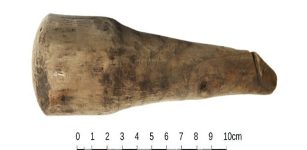 Unique Roman Artifact Discovered At Vindolanda Was More Than A Good Luck Charm
Archaeology | Feb 20, 2023
Unique Roman Artifact Discovered At Vindolanda Was More Than A Good Luck Charm
Archaeology | Feb 20, 2023 -
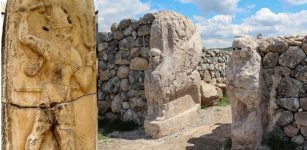 Drought Accelerated Hittite Empire Collapse – New Study Suggests
Archaeology | Feb 12, 2023
Drought Accelerated Hittite Empire Collapse – New Study Suggests
Archaeology | Feb 12, 2023 -
 Trentren And Caicai: The Battling Serpents Of Chilote Mythology
Featured Stories | Jul 10, 2022
Trentren And Caicai: The Battling Serpents Of Chilote Mythology
Featured Stories | Jul 10, 2022 -
 Cyclopean Fortress Of Sacsayhuamán – ‘Impossible’ Ancient Technology In Peru
Featured Stories | Apr 10, 2017
Cyclopean Fortress Of Sacsayhuamán – ‘Impossible’ Ancient Technology In Peru
Featured Stories | Apr 10, 2017 -
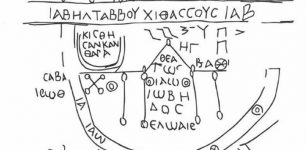 A Remarkable Curse Tablet Dated To the 1st Century AD – Unearthed In Tongeren
Archaeology | Jul 10, 2020
A Remarkable Curse Tablet Dated To the 1st Century AD – Unearthed In Tongeren
Archaeology | Jul 10, 2020 -
 Were Mysterious Giant Ancient Mustatils In Saudi Arabia Used For Ritual Purposes?
Archaeology | Mar 16, 2023
Were Mysterious Giant Ancient Mustatils In Saudi Arabia Used For Ritual Purposes?
Archaeology | Mar 16, 2023 -
 Odin: Norse God Of War And Magic – Most Complex Figure Of The Norse Pantheon
Myths & Legends | Oct 27, 2016
Odin: Norse God Of War And Magic – Most Complex Figure Of The Norse Pantheon
Myths & Legends | Oct 27, 2016 -
 Giant Geoglyphs Near The Golden City Jaisalmer In India’s Thar Desert May Be World’s Largest Drawings – Who Made Them And Why?
Archaeology | May 28, 2021
Giant Geoglyphs Near The Golden City Jaisalmer In India’s Thar Desert May Be World’s Largest Drawings – Who Made Them And Why?
Archaeology | May 28, 2021 -
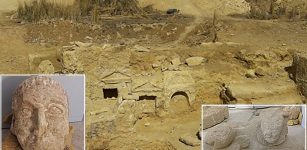 Remains Of Graeco-Roman Temple Discovered Near Egypt’s Siwa Oasis
Archaeology | Apr 6, 2018
Remains Of Graeco-Roman Temple Discovered Near Egypt’s Siwa Oasis
Archaeology | Apr 6, 2018 -
 On This Day In History: Dante Alighieri Famous For His ‘Divine Comedy’ Born – On May 9, 1265
News | May 9, 2016
On This Day In History: Dante Alighieri Famous For His ‘Divine Comedy’ Born – On May 9, 1265
News | May 9, 2016 -
 Kanishka Casket – Beautiful Ancient Buddhist Treasure In Gilded Copper
Featured Stories | Jun 14, 2021
Kanishka Casket – Beautiful Ancient Buddhist Treasure In Gilded Copper
Featured Stories | Jun 14, 2021 -
 On This Day In History: American General Benedict Arnold Commits Treason – On Sep 21, 1780
News | Sep 21, 2015
On This Day In History: American General Benedict Arnold Commits Treason – On Sep 21, 1780
News | Sep 21, 2015 -
 Scientists Investigate – Did The Human Brain Shrink 3,000 Years Ago?
Human Beginnings | Aug 6, 2022
Scientists Investigate – Did The Human Brain Shrink 3,000 Years Ago?
Human Beginnings | Aug 6, 2022 -
 Mythical Helen Of Troy: Beautiful Wife Of King Menelaus Of Sparta
Featured Stories | Jul 5, 2019
Mythical Helen Of Troy: Beautiful Wife Of King Menelaus Of Sparta
Featured Stories | Jul 5, 2019 -
 ‘Aerial Cemetery’ – Ancient Tradition Of ‘Hanging Coffins’
Ancient Traditions And Customs | Sep 9, 2018
‘Aerial Cemetery’ – Ancient Tradition Of ‘Hanging Coffins’
Ancient Traditions And Customs | Sep 9, 2018 -
 Mysterious Ancient Lost Civilization Of North America Had Interest In One Particular Constellation
Ancient Mysteries | Apr 17, 2018
Mysterious Ancient Lost Civilization Of North America Had Interest In One Particular Constellation
Ancient Mysteries | Apr 17, 2018 -
 On This Day In History: Battle Of Pinkie Was Fought – On September 10, 1547
News | Sep 10, 2016
On This Day In History: Battle Of Pinkie Was Fought – On September 10, 1547
News | Sep 10, 2016

